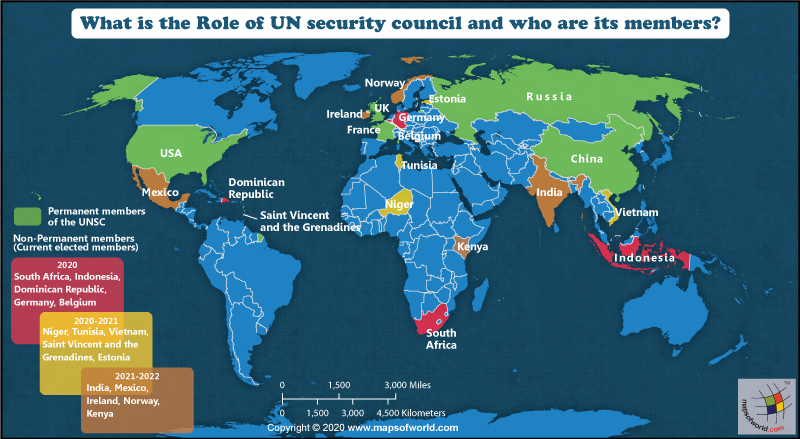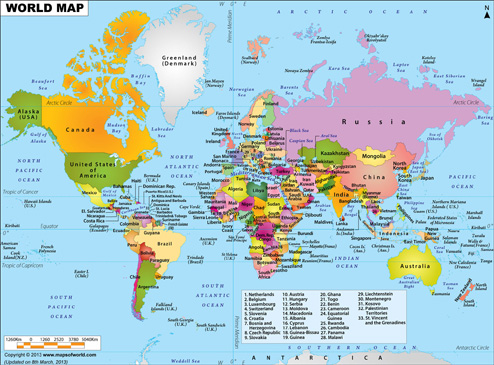What is the Role of the UN Security Council, and Who are its Members?

The United Nations Security Council (UNSC) is one of the six principal organs of the UN (United Nations). Besides UNSC, the other principal organs are the General Assembly, the UN Secretariat, International Court of Justice (ICJ), Trusteeship Council, and the Economic and Social Council (ECOSOC).
The UN Security Council is primarily entrusted with the responsibility of maintaining international peace and security, as per the United Nations Charter (signed on June 26, 1945, in San Francisco, after the UN Conference on International Organization and adopted on October 24, 1945).
This means that whenever international peace is threatened, it becomes the onus of UNSC members to meet (optional and not enforced) to resolve the conflict and maintain international peace and security. It is the responsibility of the UNSC to decide where the UN peace operation should be deployed.
What are the Purposes of the UN Security Council (UNSC)?
The UN Charter has entrusted UNSC with four primary purposes, and they are:
-
Maintenance of international peace and security.
-
Development of friendly relations among nations.
-
Cooperating to solve global problems and at the same time promote respect for human rights.
-
Make an effort to become a center for harmonizing the actions of countries.
Is the UN Security Council (UNSC) different from the other 5 Main Organs of the United Nations?
UNSC
As per the mandate, all UN members agree to accept the decision taken by the UN Security Council and accordingly carry out the same. Unlike other primary organs of the United Nations, only UNSC has the power of making decisions that the member states are obligated to implement under the UN Charter.
Other 5 Principal Organs of the UN
In the case of the other five principal organs of the UN, they make recommendations to the member states, and the member nations are not obligated to implement it.
The Difference between UNSC and Other Main Organs of the United Nations
Under the UN Charter’s Article 25, all the members of the United Nations agree to accept and, at the same time, carry out the UN Security Council’s decisions. While other principal organs of the United Nations only make recommendations to the Member States, the Security Council has the necessary power of making decisions of its own that the Member States are obligated to implement.
What is the Role of the UNSC? How does the UN Security Council Respond to Crises?
The primary role of the United Nations Security Council (UNSC) is to act on the policies/practices that are condemned by the international community. While doing this, UNSC also must keep in mind that the actions/decisions/measures undertaken by it must have minimum effect on the population or the economy of the conflicting country/countries.
The UNSC responds to various crises on a case-to-case basis. When a particular crisis or complaint is brought before the Security Council, it usually recommends the conflicting parties to reach a peace agreement through peaceful means.
What are the Options the UNSC can undertake to maintain International Peace and Security?
-
General Options
The United Nations Security Council (UNSC) can undertake specific steps to maintain international peace and security:
-
It may set forth certain principles based on which a peace agreement could be drawn between the conflicting countries/factions.
-
An investigation may be launched to check the ground realities and consequently find a practical solution to it. In some cases, UNSC also acts as a mediator between the two parties to bring peace in the region.
-
Security Council may dispatch a mission if needed.
-
It can also appoint special envoys to resolve the conflict.
-
UNSC may request the UN Secretary-General to use his/her good offices to facilitate reaching a pacific settlement of the dispute.
-
Options in case of a dispute leading to Hostilities
When a dispute between two countries/factions lead to hostilities, the first and foremost objective of the UN Security Council is to bring an end to it as soon as possible.
In such a case, there are two distinct options available to UNSC, and they are:
- It can issue ceasefire directives for preventing an escalation of the conflict.
- It can dispatch military observers or UN peacekeeping force to the conflict zone for:
a) Helping to reduce tensions.
b) Separating opposing forces.
c) Establishing a calm so that peaceful settlement can be sought between the warring factions/countries
-
Other Options for Enforcement Purposes
UN Security Council may undertake certain enforcement measures for bringing peace and security:
-
Multiple enforcement options may be implemented by the UNSC for bringing peace to the conflict region, including: Economic sanctions, Financial penalties and restrictions, Arms embargoes, and Travel bans.
-
UNSC may close diplomatic relations with the warring countries or factions.
-
It may impose a blockade to make the state agree to peace and international security.
-
Even collective military action may be enforced by the Security Council to bring peace.
What are the Factors that the UNSC takes into account while considering the establishment of a New Peace Operation?
There are various steps that the UN Security Council may adopt after receiving a complaint regarding a threat to peace. The United Nations has to take into account multifarious factors while considering the establishment of a new peace operation.
Some of the factors that UNSC has to consider before making a decision on establishing a new peace operation are:
-
Is there a ceasefire in the concerned conflict region?
-
Have the parties (involved in the conflict) committed themselves to a peace process so that they can reach a political settlement?
-
Does a clear political goal exist after the completion of the peace process? Will the political goal reflect in the mandate?
-
Is it possible to formulate a precise mandate for a UN operation?
-
Is it reasonably possible to ensure the safety and security of UN personnel during the peace operation?
-
Is it reasonably possible to receive a guarantee from the warring factions/parties regarding the safety of UN personnel?
Once these questions are answered, UNSC goes ahead with establishing a peace operation (as per its discretion).
What are the steps involved in establishing a Peace Operation by the UN Security Council?
The Security Council establishes a peace operation after the adoption of a UNSC resolution. This adopted resolution sets out the mandate and size of the mission.
Once the UN peace operation is operational, the UN Security Council monitors its work on an ongoing basis. Monitoring is done:
-
Through periodic reports from the Secretary-General.
-
By holding dedicated sessions of the UN Security Council for discussing the work of specific operations.
UNSC, as per its discretion and as it dims appropriate, can vote on the resolution for extending, amending, or ending mission mandates.
Who are the Members of the UN Security Council (UNSC)?
The UN Security Council is made up of 5 permanent members and ten non-permanent members.
The five permanent members of UNSC are:
- USA
- China
- Russian Federation
- UK
- France
The ten non-permanent members of UNSC are:
- Germany
- South Africa
- Belgium
- Vietnam
- Indonesia
- Dominican Republic
- Estonia
- Niger
- Saint Vincent and the Grenadines
- Tunisia
The General Assembly elects these ten non-permanent members for a 2-years term.
The Non-Council Member States
There are fifty United Nations Member States that have never become the members of the UNSC.
A country that is a member of the UN but not that of the UNSC may participate in the discussions of the council (without having the right to vote), in case the council considers that the interest of the concerned country’s peace and security is getting affected.
The council (on its discretion) may invite both members and non-members of the UN if they are the concerned parties to a dispute. While these countries may take part in the UNSC’s discussion but they can’t vote. The United Nations Security Council sets the conditions for a non-member State’s participation.
Related Link:
Related Map:

